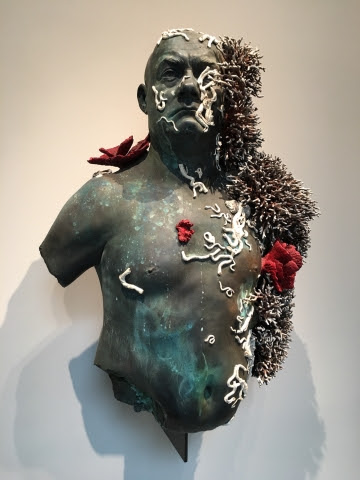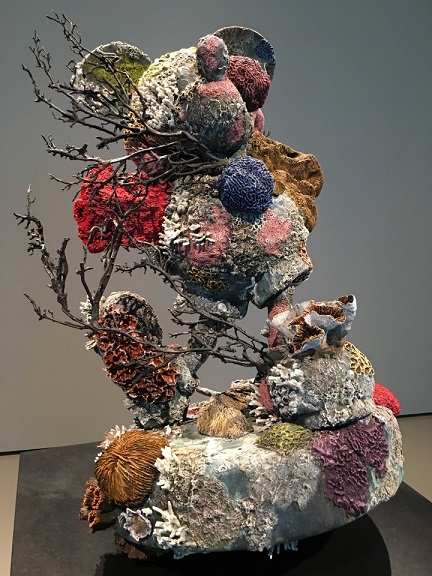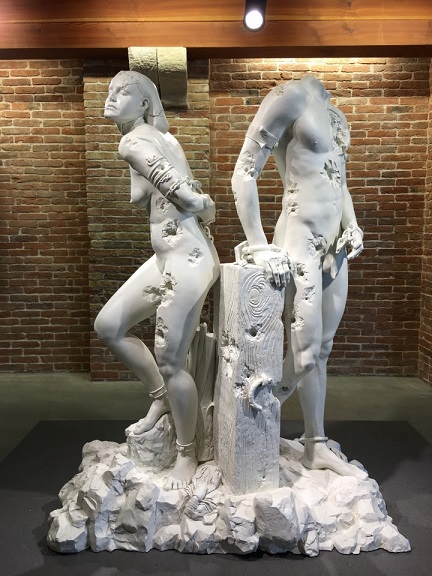
Damien Hirst, “The Fate of a Banished Man (Standing),” Carrara marble, 387 x 399 x 176 cm. The work stands at the entrance of the Punta Della Dogana (all photos by the author for Hyperallergic; works described as they appear in the exhibition guide, all are undated)
VENICE — Damien Hirst’s Treasures from the Wreck of the Unbelievable is not an exhibition. It’s a showroom for oligarchs. Comprised of about 190 works, including gold, silver, bronze, and marble sculptures, the show is undoubtedly the most expensive artistic flop in living memory.
Treasures is founded on a compelling concept that has had the life strangled out of it. The exhibition guide details the fictional discovery of an ancient shipwreck off the coast of East Africa in 2008. We’re told that scuba divers spent ten years recovering incredible finds: coins, weapons, crystals, and monumental sculptures encrusted with corals and other marine organisms. The wreck is attributed to an equally fictional collector, a freed slave named Cif Amotan II, who having amassed a fortune, supposedly loaded a ship (the ‘Unbelievable’) with his treasured collection of “commissions, copies, fakes, purchases, and plunder.” “Yet the vessel floundered,” the guide continues, “consigning its hoard to the realm of myth, and spawning myriad permutations of this story of ambition and avarice, splendor and hubris.” The exhibition is built on the premise that Hirst personally financed the excavation and has brought the objects to Venice for the public to enjoy.

Damien Hirst, “Bust of the Collector,” bronze, 81 x 65 x 36.5 cm
It’s a brilliant lie, and one that could be enormously fun and engaging. Cif Amotan II is an anagram of “I am Fiction.” The works are by Hirst, and the enormous coral encrusted sculptures are actually meticulously painted bronze. These are displayed near pristine gold or marble editions of the exact same pieces, so-called “reproductions” of the scarred wreckage finds. The exhibition is split between the Punta Della Dogana and the Palazzo Grassi, private museums operated by French billionaire François Pinault, the owner of Christie’s auction house, a collector of Hirst’s work, and the co-financier of the exhibition. This is more than a little problematic.
Outside the Punta della Dogana is “The Fate of a Banished Man (Standing),” a monumental sculpture of a horse and rider entangled in the vice of a snarling serpent. The scene resembles a Hellenistic sculpture on steroids. For a work carved out of Carrara marble it looks extraordinarily cheap. The tree stump and rocks that make up the base of the sculpture are crudely carved, even cartoonish. It’s a portent of the excessive kitsch that follows inside.

Damien Hirst, “Two Figures with a Drum Discovered by Two Divers,” powder-coated aluminum, printed polyester and acrylic lightbox, 535 x 356.7 x 10 cm
A television monitor near the ticket office displays underwater footage of the excavation. This is easily the best feature of the exhibition. The imagery is beguiling: plumes of silt drifting off half-buried treasure, giant sculptures foregrounded by schools of fish, and raised objects shimmering in the shallows. The film is bolstered by a number of large light-box photographs scattered throughout the show, which purport to document where each artifact was found. They establish an aura of mystery that the objects fail to exploit.
The first room contains three of Hirst’s monumental, coral-encrusted bronzes, “Calendar Stone,” “The Diver,” and “The Warrior and the Bear” — each successively worse than the other. At a glance the sculptures make for impressive selfie-fodder, but up close the painted coral looks unconvincing. Some, but not all of the works, are accompanied by explanatory labels. We’re told that “Calendar Stone” is similar to the Piedra del Sol housed in the National Anthropology Museum in Mexico, but that “the presence of objects of presumed pre-Hispanic, South and Central American Origin within a Roman-era wreckage is currently unexplained.”

Damien Hirst”Calendar Stone,” bronze, 422.5 x 475.8 x 172.3 cm
“The Warrior and the Bear,” a sculpture of a sword-wielding woman on a bear’s shoulders, is attributed to a maturation ritual for Athenian girls. However, the work doesn’t remotely resemble an ancient Greek sculpture. Thus, the show’s false conceit is immediately exposed. Other works include a Greek goddess with the head of a fly, a figure of Optimus Prime, multiple Disney characters, a sword emblazoned with the SeaWorld logo, and a silver bust of a figure wearing a gimp mask. A number of celebrities also make an appearance. Rihanna and Kate Moss are transformed into Egyptian deities, Pharrell Williams appears as a pharaoh, and Yolandi Visser (of Die Antwoord) stands in as the Mesopotamian goddess Ishtar.
 “Metamorphosis,” bronze, 211.6 x 88.2 x 88.7 cm
“Metamorphosis,” bronze, 211.6 x 88.2 x 88.7 cm
A generous reading is that Hirst is commenting on our true cultural values. Perhaps the ancient gods were simply the contemporary equivalents of Mickey Mouse or Rihanna? Is it absurd to revere objects whose history and meaning we can barely access or comprehend? I could almost subscribe to this idea were it not for the fact that the show is littered with iconographic retreads: unicorns, a flayed horse, and so on. Hirst retreats into familiar territory instead of exploiting the thematic potential of his myth. The flagrant kitsch of the work also sits uneasily with the show’s conceit. The work announces its fakery immediately.
Elena Geuna, the show’s curator, has propagated the show’s fiction in interviews — maintaining that it truly is an exhibition of recovered artifacts — whereas Hirst can’t be bothered. It all feels a bit half-arsed. What if Hirst had produced works that looked real, leaving the viewer to second-guess themselves? Perhaps he could have inserted real artifacts among his own creations? Such a course would have required a great deal of effort and subtlety. By comparison, Hirst’s kitsch is simply an easier means to sell juvenile trinkets to idle and unengaged one-percenters — an audience for whom a Mickey Mouse covered in coral or a minotaur raping a buxom woman apparently constitutes some sort of genuine art-historical engagement.
“As an artist you always make work from what’s around you,” Hirst told the BBC in 2010, “and you know, money was around me.” Treasures from the Wreck of the Unbelievable could have been the Blair Witch Project or Nat Tate of fake archeological excavations. Hirst is one of the very few artists with the means to achieve such ends.
 (Left_ “Gold Scorpion,” gold, 5.7 x 10 x 7.2 cm and (Right) “The Jewelled Scorpion,” gold, green and pink tourmaline, pearls, rubies. sapphires, and topaz, 10.9 x 16.2 x 11.5 cm
(Left_ “Gold Scorpion,” gold, 5.7 x 10 x 7.2 cm and (Right) “The Jewelled Scorpion,” gold, green and pink tourmaline, pearls, rubies. sapphires, and topaz, 10.9 x 16.2 x 11.5 cm
There has been an elaborate effort to give the exhibit a museological feel, as evinced by the numerous sleek display cases and explanatory labels. The Palazzo Grassi includes a scale model of the Apistos (the ‘Unbelievable’) and a suite of aged pencil drawings of the artifacts. The latter are accompanied by various archival stamps, the sort you might see on drawings that have long been housed at the British Museum or the Victoria and Albert Museum. It’s an elaborate touch, and one that is undermined by the lazy and haphazard approach to maintaining the overall illusion of the show. For instance, if the wreck was discovered in 2008, then who made these drawings? Hirst could have positioned himself in a lineage of artists who have actively interrogated the function and history of museums and collections (Fred Wilson, Andrea Fraser, and Marcel Broodthaers for instance). Instead, Hirst’s starting point was presumably, “how many works will we produce, and how should we edition them?”
Am I taking the show’s premise too seriously? Isn’t it just a peg for Hirst to hang his new body of work on? Sure — but the resulting work is insipid. The exhibition lays waste to a brilliant and engaging concept. It is also unbelievablyrepetitive, with variations of the same sculptures in bronze, gold, silver, and crystal. The sheer avarice of the show is jaw-dropping. The combined space of both museums is 54,000 square feet. For context, the Whitney Museum has 50,000 square feet of interior exhibition space.

Damien Hirst, “The Collector with Friend,” bronze, 185.5 x 123.5 x 73 cm
There are some works, which by sheer force of spectacle, manage to briefly seize your languishing interest. A prime example is “Demon with Bowl (Exhibition Enlargement),” an 18-meter resin figure built in situ at the heart of the Palazzo Grassi. It would probably be the most Instagrammed work of the show where not for the fact that it is impossible to capture in a single shot. Other behemoths include coral and non-coral variations of “Hydra and Kali,” in which the multi-limbed Hindu goddess (naked, of course) prepares to battle the renowned water monster of Greek and Roman mythology. There’s also a bright blue bronze depicting Andromeda screaming before a great white shark, a tentacled sea creature, and two piranha-like fish. These larger sculptures resemble pornographic re-imaginings of a Ray Harryhausen film.
Pinault financed the show with Hirst, though neither have stated its exact cost. When asked by New York Times reporter Carol Vogel whether he was effectively exploiting his museums for commercial gain, the collector gave a prickly response. “What can I say? I cannot avoid those comments. But this is not commercial. It’s about showing the art that I love.” In the same interview, Pinault all but admitted that he had acquired some of Hirst’s new work. “Perhaps. Probably,” he told Vogel, “but I am not going to tell you which ones!” Put simply, Pinault is promoting the art — and by extension, the market value — of an artist whose work he already owns. Assuming the show is a sell-out success, Pinault stands to enjoy a considerable appreciation to his collection’s value. To be clear, this is not illegal, but it does beg the question of what financial incentives or tax breaks, if any, Pinault’s foundation has enjoyed for housing his private collection in “the floating city.”

Installation view of “Treasures from the Wreck of the Unbelievable” (2017), Punta della Dogana, Venice
Various multi-million dollar production costs have been bandied around by a cabal of press officers, dealers, and Hirst collectors who stand to benefit from the ambiguity. Hirst is especially keen to perpetuate the mystery, as evinced in this absurd (and frankly, offensive) exchange with the BBC’s arts editor Will Gompertz:
WG: What did it cost?
DH: Er, what did we say? More than twenty, less than… [pauses] less than a hundred.
WG: [laughs] We can do better than that Damien. More than fifty or less than fifty million?
DH: Erm, I’m not sure. Oh, probably more. A lot of money.
WG: Yours?
DH: Yeah, mine.
Articles regarding Hirst and the art market are ten a penny, but an understanding of the exhibition’s economics is essential to understanding the reasons for its artistic failure. Treasures is supposed to be Hirst’s major come-back, a rebuke to his diminished popularity and slumping market value. The principal reason for this decline is saturation, both literal and conceptual. Hirst’s studio pumped out works recycling the same tired motifs: skulls, flies, butterflies, spots, and expensive pharmaceuticals. It got old and it got boring. Hirst’s 2009 exhibition at the Wallace Collection, a series of new paintings riffing off Francis Bacon — backfired spectacularly, with the late Brian Sewell memorably describing the show as “detestable” and “fucking dreadful.”

“Skull of a Unicorn,” bronze
According to Vogel’s report, the works in Treasures range from $500,000 to $5 million, and a number of collectors have already professed to purchasing pieces in advance. Each work apparently comes in an edition of three with two artist proofs. These have been branded into three aesthetic types. A collector can buy a “Coral” edition (i.e. one of the encrusted artifacts recovered from the supposed wreck), a “Treasure” (a restored artifact) or a “Copy” (a reproduction of a wreckage find). That’s around 950 works in total. You do the math. There are also three separate publications for sale, priced at £75, £150, and £250. Visitor entry to both museums is €15. The exhibit has been strategically designed to make as much money as possible. After about ten minutes into the show, it becomes glaringly obvious that Hirst has abdicated his aesthetic and conceptual ambitions to economic priorities.
If we knew how much Treasures from the Wreck of the Unbelievable cost to produce, it would probably set a benchmark for how much money can be sunk into something so visually brash and un-compelling. Though the show may be in couched in history and myth, it propagates the prevailing orthodoxy of our time — one in which our cultural heritage is increasingly molded and determined by the whims and fancies of a wealthy elite. Boredom has never come at so high a price.

“Demon with Bowl (Exhibition Enlargement),” painted resin, 1822 x 789 x 1144 cm

“Hydra and Kali,” bronze, 526.5 x 611.1 x 341 cm






















